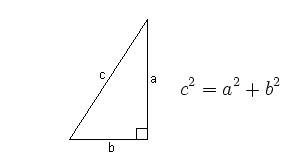Pythagorean Theorem
The Pythagorean Theorem states that for a right triangle, the square of the length of the hypotenuse is equal to
the sum of the squares of the lengths of the other two sides. Thus, for a right triangle where c equals the
length of the hypotenuse and a and b represents the lengths of the
other two sides, the Pythagorean Theorem may be depicted and
represented as follows:

Using the Pythagorean Theorem, if the lengths of any two of the sides of a right
triangle are known and it is known which side is the hypotenuse, the length
of the remaining side may be determined from the formula.


